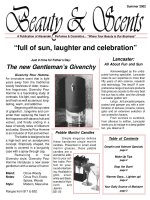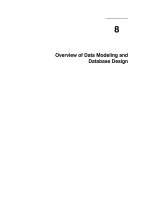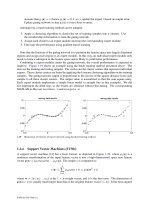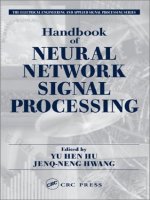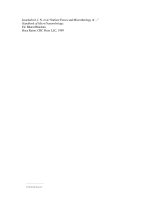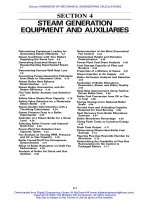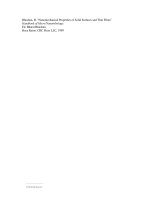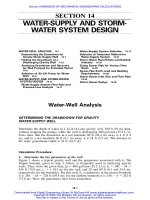Tài liệu HANDBOOK OF PLATELET PHYSIOLOGY AND PHARMACOLOGY ppt
Bạn đang xem bản rút gọn của tài liệu. Xem và tải ngay bản đầy đủ của tài liệu tại đây (34.38 MB, 582 trang )
HANDBOOK
OF
PLATELET
PHYSIOLOGY
AND
PHARMACOLOGY
Edited
by
Gundu
H. R. Rao
University
of
Minnesota
KLUWER
ACADEMIC PUBLISHERS
Boston
/
Dordrecht
/
London
Distributors
for
North,
Central
and
South America:
Kluwer
Academic Publishers
101
Philip Drive
Assinippi
Park
Norwell,
Massachusetts
02061
USA
Telephone
(781)
871-6600
Fax
(781) 871-6528
E-Mail <>
Distributors
for all
other countries:
Kluwer
Academic Publishers Group
Distribution
Centre
Post
Office
Box 322
3300
AH
Dordrecht,
THE
NETHERLANDS
Telephone
3178
6392
392
Fax
3178
6546
474
<>
Electronic Services
<>
Library
of
Congress
Cataloging-in-Publication
Data
Handbook
of
platelet physiology
and
pharmacology
/
edited
by
Gundu
H.R.
Rao.
p. cm.
Includes bibliographical references
and
index.
ISBN
0-7923-8538-1
(alk.
paper)
1.
Blood platelets Handbooks,
manuals,
etc.
I.
Rao,
Gundu
H.R
1938-
.
QP97.H36
1999
612.ri7-dc21
99-27962
CIP
Copyright
©
1999
by
Kluwer Academic
Publishers
All
rights reserved.
No
part
of
this publication
may be
reproduced, stored
in a
retrieval system
or
transmitted
in any
form
or by any
means, mechanical, photo-
copying, recording,
or
otherwise, without
the
prior written permission
of the
publisher,
Kluwer Academic Publishers,
101
Philip Drive, Assinippi Park, Norwell,
Massachusetts
02061
Printed
on
acid-free
paper.
Printed
in the
United States
of
America
List
of
Contributors
1
.
Kailash
C.
Agarwal,
Ph. D.
Department
of
Molecular Pharmacology,
Brown
University
Providence,
RI
02912,USA
2.
Colin
N.
Baigent,
Ph. D.
ATT
Collaboration
CTSU
Harkness
Building
Radcliffe
Infirmary
Woodstock Road
Oxford
0X2
6HE
United
Kingdom
3.
Rodger
L.
Bick,
M.
D.,
Ph. D.
Departments
of
Pathology
&
Pharmacology
Loyola
University
Med.
Center
21260 South First Ave.
Maywood,
IL
60153,USA
4.
David
C.
Calverley,
M. D.
USC
School
of
Medicine
1441EastlakeAve
NOR MS 34
Los
Angeles,
CA
90033,
USA
5.
Thomas
Chandy,
Ph. D.
Chemical
Engineering
and
Material
Sciences
University
of
Minnesota
Minneapolis,
MN
55455,
USA
6.
Kenneth
J.
Clemetson,
Ph. D.
Theodor
Kocher
Institut
Der
Universitat Bern
Freiestrasse
1,
Ch-3012
Berne
Switzerland
7.
Robert
W.
Colman,
M. D.
Thrombosis Research Center
Temple
Univ. Sch.
of
Medicine
3400
N.
Broad
Street
Philadelphia,
PA
19140,USA
8.
Maribel
Diaz-Ricart,
Ph. D.
Servicio
de
Hemoterapia
Hospital
Clinico
Provincial
Villarroel
170,
Barcelona
08036,
Spain
9.
Gines
Escolar,
M. D. Ph. D.
Servicio
de
Hemoterapia
Hospital Clinico Provincial
Villarroel
170,
Barcelona
08036,
Spain.
10.
Daniel
Fareed,
B.Sc.
Departments
of
Pathology
&
Pharmacology
Loyola
University Med. Center
2
1260
South First Ave.
Maywood,
IL
60153,USA
1 1
.
Jawed Fareed,
Ph. D.
Departments
of
Pathology
&
Pharmacology
Loyola
University Med. Center
2
1
260
South
First
Ave.
Maywood,
IL
60153,USA
12.
Deborah French,
M. D.
Department
of
Medicine
Mount
Sinai Hospital
&
Medical
School
One
Gustave
L.
Levy
Place
New
York,
NY
10029-6574,USA
1
3.
Mony
M.
Frojmovic,
Ph. D.
Mclntyre
Medical
Science Building
McGiIl
University
3655
Drummond
Street
Montreal,
QB
Canada,
H3GIY6
14.
Nicholas J.Greco,
Ph. D.
Platelet Biology Laboratory
American
Red
cross
1
5601
Crabbs Branch
Way
Rockville,
MD
20855,USA
15.
HolmHolmsen,Ph.D.
Department
of
Biochemistry
and
Molecular Biology
University
of
Bergen
Astradveien
19,
Bergen
N5009,
Norway
1
6.
Debra Hoppensteadt,
Ph. D.
Departments
of
Pathology
&
Pharmacology
Loyola
University Med. Center
2
1260
South First Ave.
Maywood,
IL
60153,USA
17.
Huzoor-Akbar,
Ph. D.
Molecular
and
Cellular Biology
Department
of
Biological
Sciences,
Irvine Hall
Athens,
OH
45701,USA
1
8.
G.
A.
Jamieson,
Ph. D, D. Sc.
Platelet Biology Laboratory
American
Red
Cross
15601 Crabbs Branch
Way
Rockville,
MD
20855,USA
1
9.
Gerhard
J.
Johnson,
M. D.
Veterans
Affairs
Medical Center
One
Veterans
Way
Minneapolis,
MN
55417,USA
20.
BeateKehrel,Ph.D.
Experimental
and
Clinical
Haemostaseology
Department
of
Anaesthesiology
and
Intensive Care Medicine
University
of
Muenster
D-48149
Muenster, Germany
2
1
.
Bruce
R.Lester,
Ph.
D,.
Knowledge
Frontiers
3989
Central Ave,
N.
E.,
# 625
Minneapolis,
MN
55421,USA
22.
Mahadev
Murthy,
Ph. D.
Division
Endocrinolgy,
Metabolism
&
Nutrition
Department
of
Medicine
Hennepin
County
Medical Center
914
South Eighth Street,
D-3
Minneapolis,
MN
55404.
USA
23.
Ellinor
I.
Peerschke,
Ph. D.
Cornell Medical Center
New
York University
525 E
68th Street,
Rm
F51
1
J
New
York,
NY
10021,USA
24.
Anna
S.
Radomski
Division
of R and D
Lacer,
S.A.
08025
Barcelona
Spain
25.
Marek
W.
Radomski,
M.D,D.Sc.
Division
of R and D
Lacer, S.A.,
08025
Barcelona
Spain
26.
Gundu
H. R.
Rao,
Ph. D.
Departments
of
Lab.
Med.
&
Pathol.
and
Biomed. Engineering
P.B.
609
UMHC
Academic Health Center
University
of
Minnesota
Minneapolis,
MN
55455,USA
27. A.
Koneti Rao,
M. D.
Department
of
Medicine
Temple University School
of
Medicine
3400
N.
Broad
St Rm
300-OMS
Philadelphia,
PA
19140,USA
28.
Gerald
J.
Roth,
M. D.
Division
of
Hematology
V.A.
Medical Center
1660
South Columbian
Way
Seattle,
WA
98108,USA
29.
Anita
Ryningen,
Ph. D.
Department
of
Biochemistry
and
Molecular Biology
University
of
Bergen
Astradveien
19
Bergen
N-5009
Norway
30.
Shivendra
D.
Shukla,
Ph. D.
University
of
Missouri-
Columbia
517B
Medical
Science
Building
One
Hospital Drive
Columbia,
MO
65212,USA
3
1
.
Cathie Sudlow,
Ph. D.
ATT
Collaboration
CTSU
Harkness
Building
Radcliffe
Infirmary
Woodstock Road
Oxford
OX2
6HE
United Kingdom
32.
Narendra
N.
Tandon,
Ph. D.
Thrombosis
&
Vascular Biology
Otsuka
America Pharmaceutical
9900
Medical Center Drive
Rockville,
Maryland
20850,
USA
33.
Jeanine
M.
Walenga,
Ph. D.
Departments
of
Pathology
&
Pharmacology
Loyola
University
Medical Center
2
1260
South
First
Ave.
Maywood,
IL
60153,USA
34.
Douglas
J.
Weiss,
D.
V.M.,
Ph. D.
Department
of
Pathobiology
and
Veterinary
Sciences
University
of
Minnesota
St.
Paul,
MN
55108,USA
35.
Helmut
Wolf,
M. D, Ph. D.
Departments
of
Pathology
&
Pharmacology
Loyola
University
Medical Center
2
1260
South
First
Ave.
Maywood,
IL
60153,USA
PREFACE
Despite
my
many years
of
research
and
teaching
in
platelet physiology
and
pharmacology
at the
University
of
Minnesota,
I am
often
confronted with conflicting
opinions
as to the
relevance
of
nonnucleated
platelets
in
human health
and
disease.
It
is
fascinating
to
think that
how
cells with
no
apparent nucleus, have such
a
towering
impact
on
concepts, dealing with
often
overlapping physiological (i.e.
hemostasis,
wound
healing, etc.)
and
pathophysiological
(i.e. thrombosis, stroke, atherosclerosis,
wound
healing, diabetes,
inflammation
and
cancer) components. Although
the
idea
of
compiling
new frontiers of
platelet research
in the
form
of a
book
was
quite simple
at
the
beginning,
the
project turned
out to be a
major
undertaking
from my
part.
At the
end,
I am
elated
that
the
contributors
to
this book were gracious enough
to
write chapters
in
their area
of
research expertise despite their pressing
and
highly valuable time.
For
me,
it has
been
an
humbling experience
as the
chapters that
I
have compiled,
are
written
by
people with incredible recognition
for
their relentless contributions over
the
years
to
strengthen
the
understanding
of
platelet physiology
and
pharmacology.
In my
opinion,
this
has
added
an
immense value
to the
book.
I am
proud
to
have been involved
in
this
undertaking
despite several unexpected problems
and
delays during this project.
I am
confident
that this book would
be
highly
useful
to the
community
of
scientists, including
graduate
students, researchers, academicians, physicians
and
other health care
professionals,
and
pharmaceutical industry scientists.
Circulating
platelets which lack nucleus neither adhere
to the
vessel wall
nor
aggregate
unless they encounter
a
zone
of
injury.
Upon encountering such
a
zone
of
injury,
they
become almost instantly activated, which leads
to
their adhesion
and
aggregation, both
reactions
are of
fundamental
importance
to
hemostasis
and
thrombosis. Because
of
this
reason, platelet research
has
clearly
led the way in the
continuing development
of new
strategies
and
drugs that
can
help prevent
and
treat arterial thrombosis, stroke
and
atherosclerosis. Unquestionably, platelet research
has
also impacted concepts dealing
with
many
other
diseases.
Nevertheless, considerable progress
has
been made
in the
development
of new
antiplatelet
agents
in
recent years. These newer agents
are
aimed
at
interrupting specific sites
and
pathways
of
platelet activation. Inhibitors
of
specific
platelet
agonist-receptor interactions include
antithrombins,
thromboxane
A
2
receptor
antagonists,
and
adenosine
diphosphate receptor
blockers
(i.e.
ticlopidine,
clopidogrel).
In
addition, inhibitors
of
arachidonic
acid metabolism
and
thromboxane
A
2
include
aspirin, newer COX-2 inhibitors, other NSAIDs, thromboxane
A
2
synthase
inhibitors
and
o>-3
fatty
acids. Moreover, long awaiting drugs that block
ligand
binding
to the
platelet
glycoprotein
Ilb/IIIa
complex (i.e.
tirofiban)
have
now
entered
the
market.
In
this book,
the
chapters
are
organized into
six
major
sections, including
Introduction,
Receptor
Biology,
Platelet
Biochemistry,
Experimental
Physiology,
Platelet Pathology
and
Platelet
Pharmacology. Authoritative chapters
in
each section have provided
a
collective strength
to our
initial philosophy
of
accomplishing
a
comprehensive review
of
current
concepts
in
each discipline. Although every attempt
has
been made
to
provide
an
interdisciplinary discussion
on the
subject
of
platelets
in
this book, there
may
still
be
some
gaps
and
lapses
for
which readers
are
urged
to
consult other articles
and
reviews.
I
have deliberately avoided going into
any
specific comments
on
reviews
in
order
to let
the
imagination
of the
readers
flow freely. I
believe that
the
readers
are
intelligent
enough
to
judge
and
form
their
own
critical opinion.
I
must humbly express
my
deep gratitude
to
thirty
five
scientists
in the field for
their
invaluable contributions.
I now
honestly believe that this publication would
not
have
been possible without their meritorious contributions.
I
am
deeply indebted
to my
dear
friend and
close
research collaborator,
Mahadev
Murthy,
Ph.
D.,
Director
of
Research, Division
of
Endocrinology, Metabolism
and
Nutrition, Department
of
Medicine,
Hennepin
County Medical Center, Minneapolis,
MN,
USA,
for his
commitment
and
contribution
to
this project.
He has
spent countless
hours during this project
in
reviewing
and
preparing camera ready manuscripts
for final
submission
to the
Kluwer Academic Publisher.
In
addition,
he has
written
two
excellent
chapters
for the
book.
I
must confess that this publication would
not
have been
completed without
his
generous
and
truly dedicated
efforts.
I
would like
to
take this opportunity
to
thank Charles
W.
Schmieg,
Jr., Acquisitions
Editor, Kluwer Academic Publishers,
101
Philip Drive,
Assinippi
Park,
Norwell,
MA,
02061, USA,
for
facilitating
the
publication
of
this book.
I am
specially
thankful
for his
cooperation
and
patience even
though
this project
was
delayed
by
about
four
months.
Finally,
I
would
not be in
this
field
today without
my
mentor, James
G.
White,
M.
D.,
Regents'
Professor
&
Associate Dean, Academic Health Center, University
of
Minnesota,
Minneapolis,
MN,
USA.
I
humbly
dedicate this publication
to
James
G.
White,
M.
D.,
who has
been
my
mentor, teacher, associate
and
dear
friend,
during
my
long
career
in
platelet research.
In the
end,
my
academic success
and
accomplishments
over
the
years, would
not
have been possible without
the
support
of my
wife
Yashoda,
my
daughter
Aupama
and my son
Prashanth.
I
sincerely acknowledge
and
appreciate
their
patience
and
support throughout
my
career.
Gundu
H. R. Rao
University
of
Minnesota
Professor
Minneapolis,
MN
55455
v
This page has been reformatted by Knovel to provide easier navigation.
Contents
Contributors
ix
Preface
xiii
Introduction 1
1. Platelet Physiology & Pharmacology: an Overview 1
1.1 Introduction 1
1.2 Role of Platelets in Hemostasis and
Thrombosis 2
1.3 Platelet Morphology and Biochemistry 2
1.4 Platelet Physiology 5
1.5 Altered Physiology and Function 6
1.6 Platelet Pharmacology 8
1.7 Platelet Function Inhibitory Drugs 9
1.8 Acknowledgements 14
References 15
Receptor Biology 21
2. Human Platelet Thrombin Receptors and the Two
Receptor Model for Platelet Activation 21
2.1 Introduction 21
2.2 Binding Studies 22
2.3 Membrane Microviscosity 24
2.4 Candidate Receptors 26
vi Contents
This page has been reformatted by Knovel to provide easier navigation.
2.5 The GPIb-IX-V Complex 27
2.6 Two Receptor Model 31
References 33
3. Platelet Thromboxane Receptors: Biology and
Function 38
3.1 Introduction 38
3.2 Biological Effects of TP Receptor Activation 39
3.3 Smooth Muscle Contraction 39
3.4 TP Receptor Structure 41
3.5 TP Receptor Function 49
3.6 Altered TP Receptor Function 58
References 66
4. Collagen Receptors: Biology and Functions 80
4.1 Introduction 80
4.2 Collagens 82
4.3 Von-Willebrand-Factor 83
4.4 P65 84
4.5 CD36 84
4.6 a
2
b
1
-Integrin (GPIa/IIa, VLA
2
, ECMRII) 87
4.7 GPVI/FcRg 89
4.8 Collagen-Induced Signal Transduction 90
References 92
5. Adenosine Receptors: Biology and Function 102
5.1 Introduction 102
5.2 Adenosine Receptors 103
5.3 Antiplatelet Action of Adenosine 104
5.4 Adenosine Production and Platelet
Inactivation 106
5.5 Agents Affecting Adenosine Actions 109
Contents vii
This page has been reformatted by Knovel to provide easier navigation.
5.6 Adenosine Effects on Intracellular Ca
2+
Mobilization 113
5.7 Conclusions 114
References 115
6. Platelet Activating Factor and Platelets 120
6.1 PAF Discovery, Structure and Heterogeneity 120
6.2 PAF Biosynthesis in Platelets 121
6.3 Responses of Platelets to PAF 122
6.4 PAF Receptor and Signal Transduction
Pathways in Platelets 123
6.5 Antagonist 124
6.6 PAF Receptor 125
6.7 Phospholipases 126
6.8 Platelet and PAF in Pathophysiological and
Disease States 129
6.9 Acknowledgement 133
References 133
7. Platelet Glycoprotein Ib-V-IX: Biology and Function 142
7.1 Introduction 142
7.2 Structure 143
7.3 Post-Translational Modification of GPIb-V-IX 145
7.4 Basic Functions 146
7.5 Signal Transduction 148
7.6 GPIb-V-IX as a Target for Pharmacological
Inhibition 149
7.7 Genetic Disorders Affecting GPIb-V-IX 151
7.8 Tissue Specific Expression of GPIb-V-IX
Subunits 153
7.9 Future Developments 154
References 155
viii Contents
This page has been reformatted by Knovel to provide easier navigation.
8. Fibrinogen Receptors: Biology and Function 162
8.1 Introduction 162
8.2 Characterization of the Platelet Fibrinogen
Receptor 163
8.3 Function 166
8.4 Post-Fibrinogen Binding Events 171
8.5 Conclusion 177
References 178
Platelet Biochemistry 188
9. Biochemistry of Platelet Activation 188
9.1 Function 188
9.2 Morphology and Subcellular Organelles 189
9.3 Platelet Activation and Responses 190
9.4 Signal Transduction Systems 194
9.5 Platelet Agonists and Their Signaling
Systems 206
9.6 Inhibition of Platelet Activation 211
9.7 Autocrine Stimulation and Inhibition 213
9.8 Crosstalk Between Different Signaling
Systems 214
9.9 Communication Between Platelets and Other
Blood Cells 215
9.10 Summary 217
References 217
10. GTP Binding Proteins in Platelets 238
10.1 Introduction 238
10.2 G-Proteins and Signal Transduction 240
10.3 Low Molecular Weight GTP-Binding Proteins 243
10.4 Summary 247
Contents ix
This page has been reformatted by Knovel to provide easier navigation.
References 247
11. Platelet Cyclic Nucleotide Phosphodiesterases 251
11.1 Introduction 251
11.2 Regulation of Platelet Activation By cAMP and
cGMP 252
11.3 Classification of Cyclic Nucleotide PDEs 252
11.4 Platelet cGI-PDE (PDE3A) 255
11.5 CGI-PDE Regulatory Domain 257
11.6 Platelet cGMP-Stimulated PDE (PDE2) 260
11.7 Platelet cGMP-Binding, cGMP-Specific
Phosphodi-Esterase (cGB-PDE, PDE5) 262
References 263
12. Polyenoic Fatty Acids and Platelet Function 268
12.1 Introduction 268
12.2 Platelet Function and Its Relevance to
Thrombosis 269
12.3 Polyunsaturated Fatty Acids (PUFAs) 270
12.4 Platelet Membranes and Their Lipid
Composition 271
12.5 Arachidonic Acid and Platelet Elcosanoids 273
12.6 Omega-3 Fatty Acids 276
12.7 Omega-3 Fatty Acids and Platelet Function 279
12.8 Docoshexaenoic Acid and Platelets 280
12.9 PUFAs and Their Newly Discovered Roles 281
Concluding Comments 284
Acknowledgements 285
References 286
13. Phospholipase A
2
in Platelets 293
13.1 Introduction 293
x Contents
This page has been reformatted by Knovel to provide easier navigation.
13.2 Pathways of Arachidonic Acid Release in
Platelets 294
13.3 Phospholipid Breakdown Measurements in
Stimulated Platelets 296
13.4 Phospholipase A
2
in Platelets 296
13.5 Calcium and Phospholipase A
2
298
13.6 Hydroperoxides and Phospholipase A
2
302
13.7 Phosphatidic Acid and Platelets 302
13.8 PAF and Phospholipase A
2
303
13.9 LDL and Platelet Function 304
Concluding Remarks 304
Acknowledgements 305
References 305
Experimental Physiology 315
14. Platelet Biorheology: Adhesive Interactions in Flow 315
14.1 Introduction: General Overview for Flow
Studies of Platelet Aggregation 315
14.2 General Physiology of Platelet Activation and
Aggregation in Flow 316
14.3 Range of Shear Rates in Normal and
Pathological Settings 317
14.4 Flow Regimes and Corresponding Devices
Used to Study in Vitro Platelet Aggregation 318
14.2 Ligands and Receptors Involved in Platelet
Aggregation 319
14.3 Quantitation of Aggregation: Theoretical and
Experimental Approaches 322
14.4 Platelet Aggregation in Non-Stirred Platelet
Suspensions: Role of Pseudopods 323
Contents xi
This page has been reformatted by Knovel to provide easier navigation.
14.5 Model Cell Aggregation in Near-Stasis Versus
Stirred Suspensions 324
14.6 Dynamics of Soluble Fg Binding (Receptor
Occupancy) and Platelet Aggregation as
Function of Shear Rate (66,67) 324
14.7 Dynamics of Von Willebrand Factor-Mediated
Platelet Aggregation 327
14.8 Some New Directions 330
14.9 Summary 332
Acknowledgements 333
References 333
15. Platelet Vessel Wall Interactions 342
15.1 Introduction 342
15.2 Interaction of Platelets with Vascular
Subendothelium 343
15.3 Interaction of Platelets with Extracellular
Matrices, Isolated Components of the Vessel
Wall or Purified Plasma Proteins 350
15.4 Concluding Remarks 354
Acknowledgements 355
References 355
16. Platelet-Biomaterial Interactions 362
16.1 Introduction 362
16.2 Contribution of Platelets to Thrombus
Formation 363
16.3 Platelet Adhesion on Biomaterials 364
16.4 Role of Plasma Proteins on Platelet Adhesion 364
16.5 Effect of Shear on Platelet-Surface
Interaction 370
16.6 Role of Erythrocytes and White Cells on
Platelet-Biomaterial Interactions 370
xii Contents
This page has been reformatted by Knovel to provide easier navigation.
16.7 Platelet Activation and Morphological
Changes 371
16.8 Concluding Remarks 374
Acknowledgements 375
References 375
17. Comparative Physiology of Platelets from Different
Species 379
17.1 Introduction 379
17.2 Horse 380
17.3 Ruminants 382
17.4 DOG 383
17.5 CAT 385
17.6 PIG 386
17.7 Rabbit 387
17.8 Rat and Mouse 387
17.9 Guinea PIG 388
Conclusions 389
References 389
Platelet Pathology 394
18. The Molecular Pathology of Glanzmann’s
Thrombasthenia 394
18.1 Introduction 394
18.2 Glanzmann Thrombasthenia 395
18.3 Genetics and Expression of the Platelet
GPIIb/IIIa Receptor 397
18.4 Molecular Identification of Mutations 399
18.5 Mutations Resulting in Biosynthetic Defects 408
18.6 Mutation Hotspots 412
Contents xiii
This page has been reformatted by Knovel to provide easier navigation.
18.7 Prenatal Diagnosis, Carrier Detection, and
Gene Therapy 413
18.8 Conclusions 414
References 414
19. Congenital Disorders of Platelet Signal Transduction
and Secretion 424
19.1 Introduction 424
19.2 Signal Transduction Mechanisms (Fig 1) 425
19.3 Role of Platelets in Blood Coagulation 426
19.4 Congenital Disorders of Platelet Function 426
19.5 Disorders of Platelet Secretion and Signal
Transduction 429
19.6 Signal Transduction Defects and Activation of
GPIIb-IIIa 433
19.7 Abnormalities in Thromboxane Production and
Arachidonic Acid Pathways 433
19.8 Relative Frequency of Various Platelet
Abnormalities 434
19.9 Conclusions 435
Acknowledgments 435
References 435
20. Biochemistry of Altered Platelet Reactivity in
Hypertension 439
20.1 Introduction 439
20.2 Platelet Adhesion and Aggregation Responses
in Hypertension 441
20.3 Role of Phosphoinositide in Platelet Reactivity
Inhypertension 443
20.4 Thrombin- and PGE
1
-Receptor Mediated
Signal Transduction Mechanisms in
Hypertension 448
xiv Contents
This page has been reformatted by Knovel to provide easier navigation.
20.5 Role of Nitric Oxide and Cyclic GMP in Platelet
Reactivity in Hypertension 450
20.6 Role of Thromboxane A
2
and Lipoxygenase
Metabolites in Hypertension 450
20.7 Summary 451
20.8 Acknowledgements 452
References 452
Platelet Pharmacology 458
21. Nitric Oxide-Mediated Regulation of Platelet Function 458
21.1 Introduction 458
21.2 Enzymology 459
21.3 Molecular Targets and Metabolism of NO 460
21.4 Nitric Oxide as Physiological Regulator of
Platelet Function 460
21.5 Mechanisms of NO Action on Platelets 461
21.6 Peroxynitrite 462
21.7 Nitric Oxide and Vascular Disorders 463
21.8 Nitric Oxide, Platelets and Septicemia 464
21.9 Pharmacology of NO Generation and Action in
the Platelet Microenvironment 465
Acknowledgements 469
References 469
22. Aspirin, Prostaglandins and Platelet Function:
Pharmacology and Thrombosis Prevention 478
22.1 Introduction 478
22.2 Prostaglandin Structure and Function 480
22.3 Effect of Aspirin on Prostaglandin Synthesis 481
22.4 Aspirin's Unique Effect on Platelet Physiology 483
Contents xv
This page has been reformatted by Knovel to provide easier navigation.
22.5 Molecular and Clinical Correlates: How
Aspririn-Mediated Cyclooxygenase Inhibition
Prevents Arterial Thrombosis 485
22.6 Prevention of Clinical Thrombosis by Aspirin 486
22.7 The Pharmacology of Aspirin Dose and Its
Antithrombotic Effect: How Lower Doses May
Minimize Prostacyclin Synthesis Inhibition 487
22.8 Side Effects of Aspirin 488
References 489
23. Current Developments in Anticoagulant and
Antithrombotic Agents 495
23.1 Overview 495
23.2 Newer Applications of Unfractionated Heparin 498
23.3 The Development of Low Molecular Weight
Heparins 499
23.4 Low Molecular Weight Heparins in the
Management of Thrombosis 501
23.5 Glycosaminoglycan Related Antithrombotic
Agents 503
23.6 Non-Heparin Glycosaminoglycans 504
23.7 Recombinant and Synthetic Antithrombin
Drugs 507
23.8 Antiplatelet Drugs in Development 515
23.9 Synopsis 518
References 520
24. Randomized Trials of Antiplatelet Therapy 526
24.1 Introduction 526
24.2 Antiplatelet Therapy in the Prevention of
Vascular Events Among Patients at High Risk
of Occlusive Arterial Disease 528
xvi Contents
This page has been reformatted by Knovel to provide easier navigation.
24.3 Antiplatelet Therapy in the Prevention of
Vascular Events Among Patients at Low Risk
of Occlusive Arterial Disease 536
24.4 Antiplatelet Therapy in the Maintenance of
Vascular Graft or Arterial Patency Among
Patients at High Risk of Occlusive Arterial
Disease 539
24.5 Antiplatelet Therapy in Patients at Risk of
Venous Thromboembolism 540
24.6 The Risks of Serious Bleeding with Antiplatelet
Therapy 543
24.7 Conclusions and Recommendations for
Practice 544
References 545
Index 549
1
PLATELET PHYSIOLOGY
AND
PHARMACOLOGY:
AN
OVERVIEW
Gundu
H. R.
Rao,
Ph. D.
Departments
of
Laboratory Medicine
&
Pathology
and
Biomedical Engineering
Institute
Academic
Health Center
University
of
Minnesota, Minneapolis,
MN
55455,
USA
1.1
INTRODUCTION
Dr.
Gundu
Rao has
spent
the
last
25
years
studying
and
teaching
platelet
physiology
and
pharmacology
at the
University
of
Minnesota.
Over
the
years,
he has
made
significant
contributions
to the
understanding
of
platelet
function
and its
impact
on the
pathogenesis
of
atherosclerosis
and
thrombosis.
In
addition,
he has
been
vocal
in the
national
and
international
activities
that
advocate
prevention,
early
diagnosis
and
treatment
of
Coronary
Artery
Disease
(CAD).
More
recently,
he led the
establishment
of
South
Asian
Society
for
Atherosclerosis
and
Thrombosis
(SASAT).
He
continues
to
champion
activities
on the
prevention
of
CAD,
in
the
International
arena.
Clinical, experimental
and
epidemiological
studies
have demonstrated
a
ubiquitous role
for
platelets
in the
pathogenesis
of
thromboembolic
events
and
hemorrhagic
disorders
(1-19).
Therefore,
there
is
great need
for
developing
specific
and
effective
drugs capable
of
modulating
platelet
function.
A
thorough
understanding
of the
mechanisms involved
in
regulating
platelet
function
will facilitate
the
development
of
better
antiplatelet
drugs.
Agonists interact
at
specific sites
on the
plasma
membrane
of
platelets
and
initiate
a
series
of
signaling
events (20-37). Activation signals
are
communicated
to
intracellular
effector
enzymes
through
transmembrane
receptors that
are
coupled
to
GTP-binding
proteins (29).
Stimulation
of
intracellular enzymes
facilitate
the
formation
of
second messengers capable
of
mobilizing
cytosolic
free
calcium
from
internal membrane stores. Ionized calcium
is the
primary
bioregulator
of
various
platelet responses
(31,32).
Agonists
as
well
as
antagonists
are
capable
of
modulating cytosolic calcium
levels.
Elevation
of
cytosolic calcium
stimulates phospholipase
A
2
,
liberates
arachidonic
acid
from
membrane phospholipids,
promotes assembly
of filamentous
actin,
granule mobilization
and
secretion
of
granule
contents
(31).
The
mechanisms involved
in
platelet activation
facilitate
the
expression
of
binding
sites
for fibrinogen on
platelet
glycoprotein
(GP)
1
lb/11
Ia
receptor
(38-45).
Activated
GP 1
lb/11
Ia
receptor
binds
fibrinogen and
this binding
seems
to
contribute
to
the
formation
of
platelet aggregates
and
growth
of the
thrombus.
Major
pharmacological
approaches have
focused
on
developing inhibitors capable
of
preventing
one or
more
signaling mechanisms (33). Currently available
antiplatelet
drugs
are
quite
effective
in
preventing platelet activation, including aggregation
and
secretion. However, they
are
less
effective
in
preventing platelet interaction with
biomaterials
and
cell matrix
components.
Intense
research is in
progress
to
develop newer antiplatelet drugs.
A recent
review
of
antiplatelet
clinical trials concluded that
use of any
antiplatelet drug significantly
reduces
the
development
of
cardiovascular events
relating to
coronary artery
disease.
The
articles
in
this book which
are
written
by
experts, provide
a
comprehensive
review on
various aspects
of
platelet physiology
and
pharmacology.
1.2
Role
of
platelets
in
hemostasis
and
thrombosis
Platelets contribute significantly
to the
normal
hemostatic
process
(1-6).
They play
a
critical role
in the
recognition
of
injured
vasculature,
formation
of
hemostatic plugs,
prevention
of
bleeding, retraction
of
clots
and
wound healing (6-9). When they develop
severe
dysfunction
they contribute
to the
pathogenesis
of
hemorrhagic
disorders.
Whereas, when they
are
hyperactive, they
can
initiate events leading
to
clinical
complications
associated with cardiovascular disorders
(10-16).
Platelets circulate
in the
blood
as
nonadhesive
disc shaped cells. When activated they undergo
a
series
of
discrete
transformations.
The
degree
of
activation depends upon
the
strength
of the
activating
stimuli
and the
information
available
on the
interactive domains
of the
cell
matrix
components.
For
instance, interaction with
laminin
will
result in
minimum activation
and
formation
of
focal
adhesion. However,
fibronectin
will promote complete spreading
of
platelets. Whereas, collagen will induce
formation
of
aggregates
as
well
as
secretion
of
granule contents. Platelet
responses
that
are
well recognized include development
of
stickiness,
adhesion, change
in
shape, irreversible aggregation
and
secretion
of
granule
contents. Platelet activation
is a
prerequisite
for
the
formation
of a
hemostatic plug
and
arrest
of
bleeding
at the
injured
site. Although
formation
of a
hemostatic plug
is a
natural
response
to
injury,
the
role
of
platelets
in
atherosclerosis, thrombosis
and
stroke
are
pathological manifestations
(1-19).
1.3
Platelet morphology
and
biochemistry
Blood
platelets have
a
discoid
form
in
their resting state.
A
circumferential band
of
microtubules
support this shape. This characteristic shape facilitates their movement
in
the
circulating blood
at the
periphery
of the flow
close
to the
vessel
wall (Fig.
1).
Ih
order
to relate
cell structure
to the
functional
responses,
the
work
by
White
has
divided
anatomy
of
the
platelet into three distinct zones,
the
peripheral zone,
the
sol-gel zone
and
the
organelle
zone (20).
The
peripheral zone consists
of
membranes
and
closely associated
structures
including
lipid
bilayer,
cytoskeletal
proteins,
transmembrane
proteins, various
Figure
1.
Scanning
electronmicrograph
of
resting platelets
The
characteristic shape
of
circulating
discoid
platelets
is
critical
for
their passage
in the
vessel
wall with smooth blood
flow
(Courtesy: James
G.
White, MD).
glycoprotein-rich
interactive domains, transmembrane receptors
for
soluble agonists such
as
epinephrine,
adenosine
diphosphate
(ADP),
thrombin,
thromboxane
and
platelet
activating
factor
(PAF),
GTP-binding
proteins,
integrin
(GP
lib/11
Ia,
GPla/lla,
GPlc/1
Ia)
and
non-integrin
(GPlV,
GPV,
GPlb/lX)
receptors
and ion
channels (reviewed
in
subsequent chapters).
Figure
2.
Electronmicrograph
of a
discoid platelet (sectioned
in the
equatorial plane)
Microtubules
that support
the
discoid
form
are
seen beneath
the
plasma membrane;
Organelles
such
as
dense
bodies,
granules
(alpha,
lysosomal)
and
mitochondria
can
also
be
seen (Courtesy: James
G.
White, MD).
Figure
3.
Schematic representation
of
discoid
platelets:
Features
of a
discoid
platelet:
EC,
exterior coat;
CM,
cell
membrane;
CS,
channels
of the
surface connected
canalicular
system;
SNfF,
submembrane
filaments;
Sol-
gel
zone contains
actin
microfilaments,
microtubule(MT),
and
glycogen
(GIy),
formed elements;
a-granules
(G),
dense bodies (DB)
and
mitochondria
(M);
DTS and OCS are
part
of the
membrane system
(Courtesy:
James
G.
White,
MD)
The
morphological
features
described above support
the
discoid shape
in
nesting
platelets
and
thus, providing
a
contractile system that facilitates shape change, pseudopod
formation,
contraction
and
secretion.
The
major
portion
of
the
contractile system involves
actin.
Other proteins
of the
platelet contractile system include,
myosin,
tropomyosin,
acting binding protein,
cc-actinin,
gelsolin,
profilin,
vinculin
and
spectrin.
The
organelle
zone consists
of
granules, dense bodies, peroxisomes, lysosomes, mitochondria
and
glycogen. This zone serves
as the
storage site
for
various enzymes, non-metabolic
adenine
nucleotides, serotonin,
a
variety
of
proteins, calcium,
and
antioxidants
such
as
ascorbic
acid,
taurine,
and
glutathione.
The
unique complex membrane system (DTS
&
OCS) plays
a
very critical role
in
platelet
pathophysiology.
The
dense dense
bodies(DB)
are the
site
for
calcium,
adenine nucleotides
and
serotonin sequestration.
The DTS is the
site
where
enzymes
of
arachidonic
acid metabolism
and
prostaglandin
synthesis
are
localized.
The
sol-gel zone constitutes components
of the
cytoplasm.
It
contains
fibers, filaments and
proteins
in
various states
of
polymerization. (Fig.
2)
The
surface-connected
open canalicular system (OCS) provides
access
to the
interior
for
plasma-borne
substances
and it
serves
as a
conduit
for
products secreted during
the
release
reaction (Fig.
3).
1.4
Platelet
physiology
Physiological agonists cannot penetrate
the
plasma
membrane
barrier
and
therefore,
they
must
first
coiq)le
to
specific
interactive domains
on the
platelet
surface
membrane
in
order
to
trigger
the
sequence
of
activation signals
(21
-29, reviewed
by
Ryningen
and
Holmsen
in
this book).
The
physiological agonists that
are
known
to
activate platelets include
adenosine
diphosphate
(ADP),
epinephrine
(adrenaline),
thromboxane
A
2
(Tx^
)>
thrombin,
and
platelet activation
factor
(PAF).
In
addition,
cell
matrix components such
as
laminin,
fibronectin,
collagen
and von
Willebrand
factor
also trigger
platelet
activation.
Platelet
adherence
to
surfaces
and
resulting activation leads
to the
development
of
stickiness,
change
in
shape,
formation
of
pseudopods, adhesion,
followed
by
aggregation
and
secretion
of
granule contents. (Fig.
4).
Receptors
for
ADP, epinephrine, thromboxane, thrombin
and PAF
have been
well
characterized (27,
31,
reviewed
in
other chapters). Membrane spanning receptors
of
epinephrine, thrombin
and
thromboxane
are
coupled
to the
ubiquitous
GTP-binding
proteins. Platelets contain
monomeric,
low
molecular weight
G
proteins
as
well
as
heterotrimeric
membrane associated
G-proteins.
GTP
binding
to the
a-subunit
of G-
proteins
facilitates
the
interaction with
effector
enzymes, resulting
in the
hydrolysis
of
GTP
to
GDP, which terminates
its
stimulatory role (29).
Figure
4.
Scanning
electronmicrograph
of
activated platelets Platelet activation resulting
in
shape change
and
formation
of
pseudopods
(PS) (Courtesy: James
G.
White, MD).
Agonist-mediated activation
of
platelets stimulates
phospholipase
C
(PLC)
and it
then
triggers
the
hydrolysis
of
phosphatidyl
inositol
4,5-bisphosphate
(PIP
2
),
the
formation
of
second messengers such
as 1,
2-diacylglycerol
(DAG)
and
inositol
1,4,
5-trisphosphate
(IP
3
)
(30-38, also
reviewed in
this book). Diacylglycerol (DAG)
is a
substrate
for
protein
kinase
C
(PKC), which
is
recognized
as a
multifunctional
enzyme (25). This
lipid
intermediate
is
also
a
substrate
for
phosphatidic
acid. Diacylglycerol (DAG) induces
translocation
of
cytosolic
PKC to
membranes, which acts
as a
trigger mechanism
for its
activation.
On the
other hand,
IP
3
is
known
to
mobilize ionized calcium
from
internal
membrane stores. However,
thrombin
and PAF can
also mobilize
calcium
from the
external milieu. Ionized calcium plays
a
central role
in all
platelet
functional
responses
and
it is
therefore
considered
as an
important
bioregulator
in
platelet pathophysiology
(31
-
36,
also
reviewed
elsewhere
in
this book). Elevated
cytosolic
calcium
is
essential
for
the
assembly
of filamentous
actin.
Furthermore,
it is
also considered
essential
for the
activation
of
phospholipase
A
2
,
a key
enzyme
to
mobilize
arachidonic
acid (AA)
from
membrane
phospholipids
for
further
metabolism (reviewed elsewhere
in
this book).
It is
well documented
that
free AA
then
is
converted
to
cyclic
endoperoxides such
as
PGG
2
and
PGH
2
in the
presence
of
cyclooxygenase (27,
11,
23). These transient metabolites
are
further
transformed
into novel
thromboxanes
by
thromboxane
synthetase.
Thromboxane
A
2
is the
major
metabolite
of AA
metabolism
in
platelets
(31).
It is a
vasoconstrictor
and
potent platelet agonist.
In
endothelial cells,
AA is
converted
to
cyclic endoperoxides
by
cyclooxygenase,
and
these metabolites
are
further
transformed
to
prostacylcin
(PGI
2
)
by
prostacyclin
synthetase.
Prostacyclin
is a
vasodilator
and a
potent platelet antagonist
(31).
Thus both
phosphoinositol
pathway
and AA
metabolism, contribute significantly
to the
activation
of
platelets
by
soluble agonists (27,
2, 10,
11,
14). These
events
promote
the
expression
of an
activation dependent epitope
on the
platelet
glycoprotein
GPl
lb/11
Ia
receptor
(39-46).
Activation
of
this receptor promotes
fibrinogen
binding
and
facilitates
platelet adhesion, aggregation
and
growth
of the
thrombus. However,
activation
of
this
receptor is not
essential
for its
interaction with
surface
bound
fibrinogen.
Apart
from the
agonists mentioned above, shear
force
also
can
induce platelet activation (discussed
elsewhere
in
this book).
It is
believed that
fibrinogen
plays
a
role
in the
adhesion
and
aggregation
of
platelets
under
low
shear rates. Furthermore,
at
high
shear
forces
von
Willebrand
factor
interaction with
GP
Ib/IX
seems
to be
important
(31,
also discussed
in
other
chapters
of
this book). Circulating adhesive proteins such
as fibrinogen,
cell
matrix
components, bacterial membrane proteins, certain tumor cells
and
biomaterial
surfaces
also interact with
the
platelet plasma membrane
at
discrete domains. Binding
of
ligands
to
integrinandnon-integrin
receptors
induce activation signaling mechanisms (27,
31,
62,
also discussed
in
other chapters
of
this book). Binding results
in the
activation
and
stimulation
of
various
effector
enzymes
and
formation
of
second
messengers,
leading
to
aggregation
and
secretion
of
granule contents.
Specific
mechanisms involved
in the
process
of
centralization
of
granules
and
release
of
their contents
are
poorly
understood(26,27,
31).
1.5
Altered
physiology
and
function
Many
investigators have attempted
to
correlate
the in
vitro
functional
response of
platelets
to
clinical manifestations
of
thrombotic
episodes
or
bleeding diathesis
(8,10,12,
15, 30,
46,47,
also discussed
in
other chapters). Yet,
it
remains
a
difficult
task
to
establish
a
clear
relationship between
specific
functional
responses
and
their role
in
normal
hemostasis.
However,
the
presence
of
functional
glycoprotein
GPlb/lX
and GPl
lb/11
Ia
receptors and
the
ability
of
platelets
to
undergo shape change, spread, become sticky, irreversibly
aggregate,
or
release granule contents,
are
considered essential
for
normal
hemostatic
function.
Drug-induced impairment
of
signal
transduction
and
biochemical lesions,
resulting from
procedures
such
as
surgery, dialysis, angioplasty,
may
also lead
to
platelet
dysfunction.
Platelets
may
also develop biochemical lesions during storage
and
thus,
may
carry
dysfunctional
characteristics making them less suitable
for
transfusion. Although
intracellular
calcium elevation
is
considered important
for
eliciting platelet responses such
as
contraction
and
secretion,
its
role remains questionable
in
platelet shape change
and
